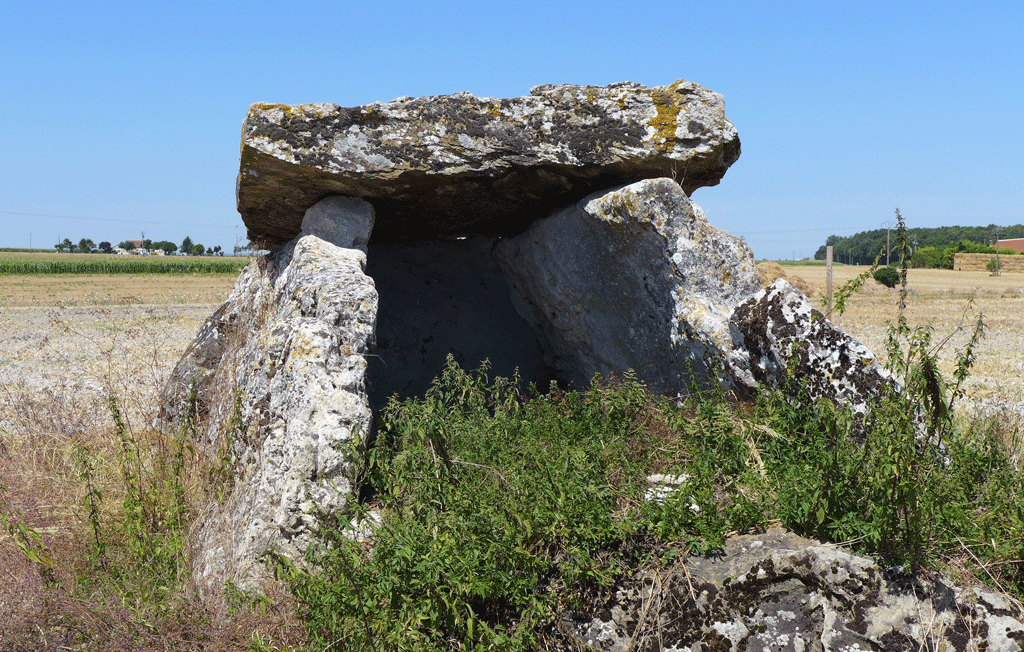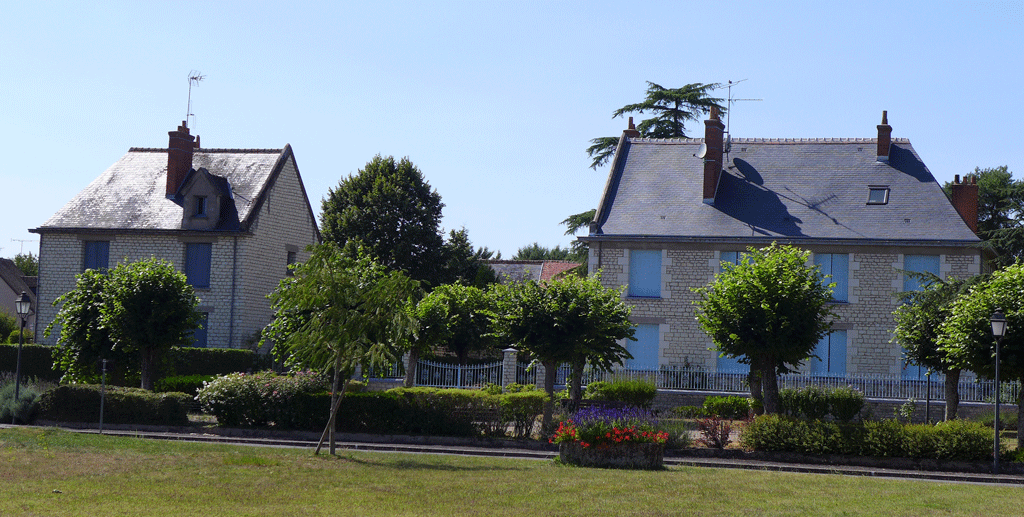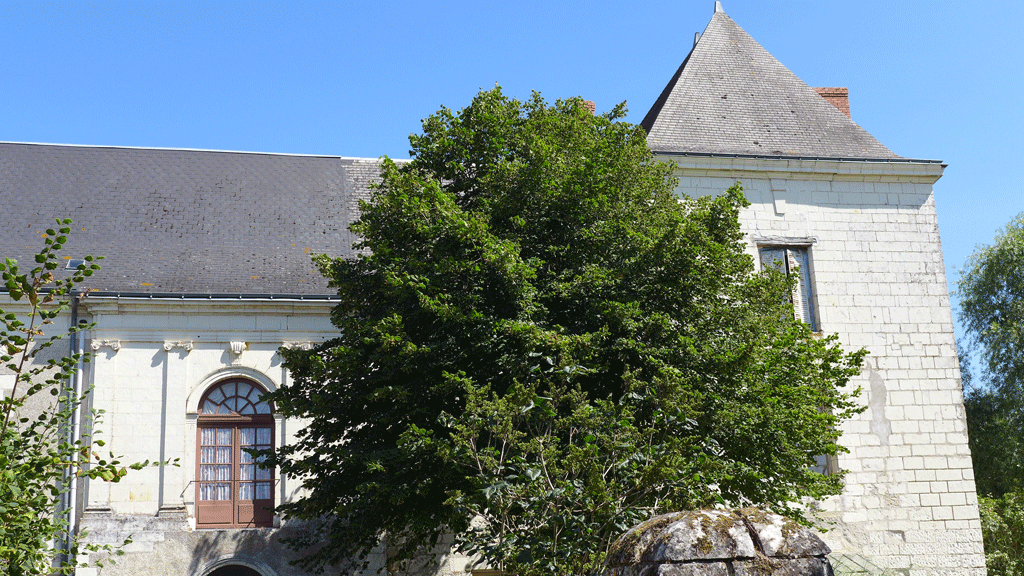It’s a Sunday in the middle of a heat wave and we’ve chosen a cycling itinerary from our new Tours-Basque Coast book (Eurovélo 3) that we don’t know yet. It goes through Sainte-Maure-de-Touraine, famous for its goats cheese, and Maillé, infamous for being the site of the second largest massacre in World War II after Oradour sur Glane. Unfortunately, my trusty iPhone has had a little accident and I’m going to have to rely on Jean Michel’s camera which has a Lumix lens but is not as easy to handle.

We park the car in the shade at Sainte-Catherine-de-Fierbois, 8 km north of Saint-Maure and set off on our bikes, stopping almost immediately for coffee at an attractive little auberge called Jeanne d’Arc with a terrace looking onto a statue of Joan of Arc who stayed here, wearing men’s clothing, for two nights in March 1429 on her way to Chinon. Her “voices” also revealed the existence of Charles Martel’s rusty sword behind the altar of Saint Catherine’s chapel which she then adopted as her weapon.

We visit the pure flamboyant gothic church next door which replaced the chapel after it was burnt down in 1440. One of the chapels inside the church is dedicated to Saint Catherine and there is another statue of Joan of Arc.

Devotion to Saint Catherine was so popular in the middle of the 16th century that Louis de Rohan, seigneur de Sainte-Maure, was authorized by the king to build walls and moats around the village (they’ve now disappeared) so that it could be elevated to the rank of a town.

After a fruitless attempt to visit the local château, we ride out of town towards a park and another more recent château but we have no idea what it is.

We soon arrive at Sainte Maure which has a large square surrounded by several historical buildings. The most impressive is an enormous covered market, 48 metres long, 25 metres wide and 20 metres high. You wonder just how much goat cheese they can sell! It is closed but when we go around the back, we discover an open door and wander inside among the permanent stands which are closed today.

The two monumental doors were added during restoration in 1672 by Princess Anne de Rohan. Unfortunately, they were damaged during the Revolution in 1798.

The town hall with its classical façade looks very majestic next to the local PMU café where the locals are enjoying a Sunday aperitif. Who knows, it might even be open when we pass through again on our way back.

We stop in front of the 12th century “Belle Image” inn, right on the Camino which accounts for the scallop shell on the façade alongside the motto “good wine and good lodgings at La Belle Image”. It finally closed in 1987 and now houses the public revenue department.

We cycle down to the ruins of the château built in 990. The 14th century tower is all that remains of the protective walls. After the French revolution the castle housed the local gendarmerie until 1836 when it became a boys’ school until 1968.

There is one more place to visit before we go – the Virgins’ Chapel and Fountain – which is out of town a bit. As it’s very hot, not to say extremely hot, we don’t want to run the risk of losing our way so we ask at a newly open Portuguese wine and grocery store as I figure they’ll know about the chapel. “It’s up a very steep hill”, they tell us. It’s certainly not as taxing as our 1.6 km in Germany in July, but it still requires major leg power particularly in such intense heat.

I flake out at the top while Jean Michel looks around. There is a bench in the shade overlooking the town so we decide to have lunch there so that I can regain my strength.

The present chapel, inaugurated in 1892 replaces a chapel built in 1760 on the site of a fountain reputed to heal milk ringworm. The chapel is closed so we don’t get to visit the inside. Apparently it’s hardly ever used

As we cycle down the hill, I am able to observe a beautifully restored wash house and take a closer look at a sign that I noticed on the way up when I obviously was not going to stop. A free 22-seat mini-bus called the “carosse du marché” picks up people every Friday from mid-June to mid-September to take them to the produce market. The market must be really enormous!

The next monument on our list is a dolmen or Pierre fondue (melted stone) and is very hard to locate. We eventually come across a very small sign and follow it along an extremely stony path. On the way we see our first herd of goats. Considering how famous the cheese is here, we are surprised not to see more. Some of them are resting out of the hot sun in a large unattractive wrought-iron shelter with a Christmas manger in front.

The dolmen is a bit of a disappointment, but then, dolmens usually are. The 1.7 metre high megalith, made of Turonian limestone and sandstone, is the remnant of a covered walkway: an aisle formed by a double row of upright stones, covered with slabs. It is a Neolithic gravesite with its opening facing the rising sun. It was erected during the “new stone age” (about 5,000 to 6,000 BC) when hunters and gatherers became farmers and breeders. I try to imagine its significance but the broiling sun makes it difficult and I let Jean Michel go and take the photo close up.

Another dolmen, a menhir this time, is shown on our cycling map but we vote only to visit it if it’s on our route. It isn’t, so we push on to Maillé. We see the war museum on our right but it looks completely closed. What a disappointment. We approach the gate and discover it is open. A very friendly woman appears, expressing surprise at our arrival. “I didn’t expect anyone to come today”, she says, “because of the heat.” Only mad dogs and Englishmen, I think.

The Maillé Massacre, as it is called, took place on 25th August 1944, the day that Paris was liberated, as revenge on local Resistance activities. The German forces killed 124 out of the 500 inhabitants of the village which was then burnt to the ground. Only 8 houses out of 60 remained. The village was reconstructed. It was mainly thanks to the financial support of an American Francophile couple, the Hales, that the orphaned children and remaining adults were able to get on with their lives.
A temporary exhibition consists of photos of inhabitants who were about 10 years old when the massacre took place, with recorded quotations of their experience on a video screen. We leave feeling very subdued. In the meantime, the friendly lady has put two of our water bottles in the freezer. The cold water is much appreciated as there is not a single café or shop open.

We continue to Nouâtre, our destination for today, built on the Vienne River. We eventually locate Château de la Motte, but there isn’t much to see. It has been turned haphazardly, it seems, into individual apartments.

Back in Maillé, we visit the outside of the little 11th century church with its Romanesque porch and external staircase. Inside there is a memorial to the victims of the massacre but it is only open during heritage weekend in September. I later learn my friend Susan from Days on the Claise has written a post about Maillé.

We arrive back in Sainte-Catherine-de-Fierbois exhausted but get a kick out of photographing the local recipes illustrated on billboards around the main square. I hear an older woman and her adult son clucking about the recipes but can’t catch their words. I don’t care! I’m going to try that Goat Cheese Tart!




